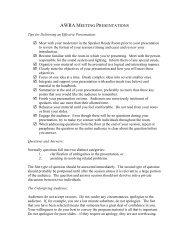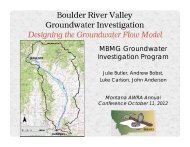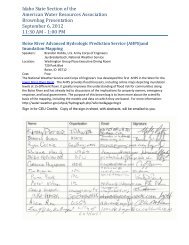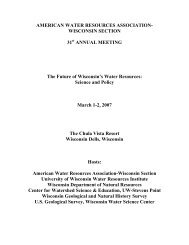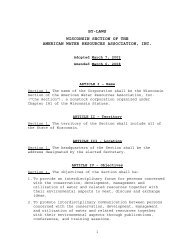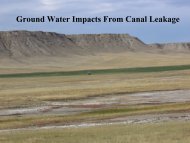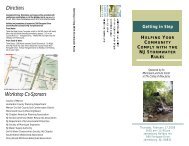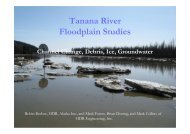Wisconsin's Role in Great Lakes Restoration - American Water ...
Wisconsin's Role in Great Lakes Restoration - American Water ...
Wisconsin's Role in Great Lakes Restoration - American Water ...
Create successful ePaper yourself
Turn your PDF publications into a flip-book with our unique Google optimized e-Paper software.
Soil Moisture and Ra<strong>in</strong>fall Intensity Thresholds for Runoff Generation <strong>in</strong> Southwestern<br />
Wiscons<strong>in</strong> Agricultural Bas<strong>in</strong>s<br />
Timothy F. Radatz, M<strong>in</strong>nesota Agricultural <strong>Water</strong> Resources Coalition, Pigeon Falls, WI,<br />
radatz@mawrc.org<br />
Anita M. Thompson, Department of Biological Systems Eng<strong>in</strong>eer<strong>in</strong>g, University of Wiscons<strong>in</strong> –<br />
Madison, Madison, WI, amthompson2@wisc.edu<br />
Frederick Madison, Department of Soil Science, University of Wiscons<strong>in</strong> – Madison, Madison,<br />
WI, fredmad@wisc.edu<br />
Identify<strong>in</strong>g time periods when land application of manure is likely to contribute to surface<br />
runoff contam<strong>in</strong>ation is important for mak<strong>in</strong>g proper management decisions and reduc<strong>in</strong>g the<br />
risk of surface water contam<strong>in</strong>ation. The goal of this study was to improve our understand<strong>in</strong>g<br />
of the factors that <strong>in</strong>fluence runoff generation <strong>in</strong> agricultural watersheds dur<strong>in</strong>g non-frozen<br />
ground periods. Six small bas<strong>in</strong>s (rang<strong>in</strong>g from 6 to 17 ha) with<strong>in</strong> two southwestern Wiscons<strong>in</strong><br />
farm sites were <strong>in</strong>strumented and surface runoff cont<strong>in</strong>uously monitored from 2004 to 2007 by<br />
the University of Wiscons<strong>in</strong> Discovery Farms Program (DFP) and the University of Wiscons<strong>in</strong><br />
– Platteville Pioneer Farm (PF). The soils <strong>in</strong> all bas<strong>in</strong>s were silt loam. A direct-plant<br />
management strategy and corn-soybean crop rotation were utilized with<strong>in</strong> bas<strong>in</strong>s at the first<br />
farm site (DFP). The second farm site (PF) utilized a conventional tillage system (chisel plow<br />
<strong>in</strong> the fall followed by soil f<strong>in</strong>isher <strong>in</strong> the spr<strong>in</strong>g) and a corn-oat-alfalfa crop rotation with<strong>in</strong> the<br />
bas<strong>in</strong>s. Tillage differences between the farm sites <strong>in</strong>fluenced the amount of surface runoff<br />
generated dur<strong>in</strong>g the non-frozen ground period. At PF, the amount of precipitation leav<strong>in</strong>g the<br />
landscape as surface runoff (2%) was approximately two times greater compared to DFP<br />
(0.9%), <strong>in</strong>dicat<strong>in</strong>g that the direct-plant management system was better at reta<strong>in</strong><strong>in</strong>g<br />
precipitation than the chisel plow/soil f<strong>in</strong>isher system. An antecedent soil moisture (ASM)<br />
threshold of 0.39 cm 3 cm -3 for runoff generation was determ<strong>in</strong>ed for all six bas<strong>in</strong>s. Below this<br />
threshold, runoff coefficients (runoff depth divided by precipitation depth) were near zero.<br />
Above this threshold, runoff coefficients <strong>in</strong>creased with ASM. Maximum 30 m<strong>in</strong>ute ra<strong>in</strong>fall<br />
<strong>in</strong>tensity (I30) thresholds for runoff generation <strong>in</strong>creased as ASM decreased and as crop<br />
cover <strong>in</strong>creased. Avoid<strong>in</strong>g manure application dur<strong>in</strong>g time periods when soil moisture is near<br />
or above a critical soil moisture threshold would decrease the risk of surface water<br />
contam<strong>in</strong>ation.<br />
23






